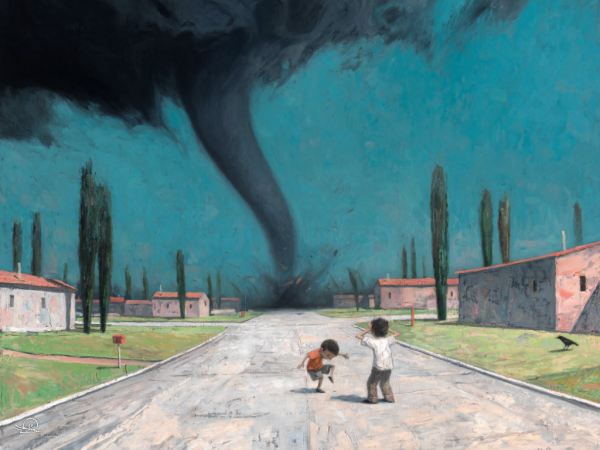The Rules of Summer; Shakespeare at Play | App Reviews

Interior screen, "Never Step on a snail." from "The Rules of Summer" (We Are Wheelbarrow)" Tan
The Rules of Summer. Shaun Tan. We Are Wheelbarrow. 2014. iOS, requires 6.3 or later. Version 1.3. $4.99.
Gr 3 Up –Atmospheric, textured, surreal—the work of Shaun Tan is easily described as cinematic. His tableaux appear to be stills from a larger story, his settings hint at a world fully imagined far beyond the frame. Music and other sounds are implied by objects and actions in the picture. And in fact, Tan is an animator as well as an illustrator, receiving an Academy Award in 2011 for Best Short Film (Animated) for his adaptation of his The Lost Thing (Lothian Books, 2000).
So it seems quite natural—as natural as anything associated with the eerie, offbeat imagination of Tan could be—for him to create an app version of his new book Rules of Summer (Scholastic, 2014). The title itself implies sunlit, child-governed anarchy, exploration, arbitrary tests of fearlessness—a world in the process of being interpreted anew through a child’s eyes. And in this app, what they see is mind-blowing.
The user is invited in with the words, “This is what I learned last summer.” Each page features a single line (“Never leave one red sock on the clothesline.” “Never step on a snail.” etc. ) and a hand-drawn icon. Tapping the icon pulls viewers into a painting, landing on a very small detail of the big picture. Subsequent pictures tell a story of two boys, perhaps brothers, adventuring with various robotic and/or monstrous friends through odd landscapes. The print version of Rules is easier to decipher, narrative-wise. But the oblique presentation of Tan’s paintings in the app, together with the muted clanks, birdsong, hums and tinkles of the sound track leaves more room for speculation. It’s a beautiful app that rewards repeat visits.
Shakespeare at Play. Rick Chisholm Productions, Ltd. 2014. iOS, requires 6.0 or later. Version 6.2. Free for basic app. $3.99 ea. for Video eds., $1.99 ea. for Notes eds.
Gr 7 Up –Imagine how different our experience of a film would be if all we had to go on was the written script; if we never viewed the film on the big screen. Without the actors, sets, lights, and music our experience would be completely different. The same can be said of Shakespeare’s plays, which were in many ways the films of his day, a time when literacy rates were extremely low and plays were written to be seen as live performances. The Bard’s words and phrasing were unfamiliar and confusing to many back then, and even today, it’s a rare student who doesn’t struggle with Shakespeare on first encounter.
Tim Chisholm, the founder of Shakespeare at Play, and Rick Chisholm, the producer, have taken these lessons to heart in the design of their app, which allows students to watch custom video productions of Shakespeare’s plays and at the same time scroll through the complete texts, word for word, scene by scene, stopping, starting, and rewinding the video as needed or accessing definitions. What’s different, and so helpful, is that the video has been produced specifically to correspond to Shakespeare’s complete plays, unlike so many film versions that deviate from the original texts, often changing Shakespeare’s wording and eliminating scenes entirely.
Each play in the series is organized into acts and scenes and the lines of the original texts are all numbered for easy reference. The video performances are professionally produced and the youthful actors will appeal to high school viewers. Costumes and sets are minimal, as they were in Shakespeare’s day, but the props, lighting, and fog effects are used to great advantage to help support the action and enhance the emotional tenor of the scenes.
The app is clearly designed and easy to use, starting with the landing page, called My Library, which displays the available plays. Once a play is selected, the screen splits in two, with a wide, horizontal video window on top and a scrollable text window on the bottom. Both the video and the text windows can be expanded to full screen at any point.
Just under the video window, in the middle of the screen, three clickable icons indicate additional information that’s been designed to scaffold the viewing and reading experience for students each step of the way: a megaphone (for audio introductions to each scene by Noam Lior of the University of Toronto with plot highlights and other items of interest); a feather (for text descriptions of scenes); and two theatrical masks (for text descriptions of characters). In addition, informative annotations, also by Lior, are ever-present in the bottom window. A custom glossary of words and phrases, Shakespeare FAQs, and options to download any or all of the video scenes are readily available in the index, which is accessed through an icon at the top left of the screen.
The app is free with text-only versions of eight of Shakespeare’s plays. Currently, video versions for Hamlet, Macbeth, and Romeo and Juliet and Notes Editions, which include additional text information but no video, for A Midsummer Night’s Dream, Hamlet, Macbeth, and Romeo and Juliet are also available from within the app.
RELATED
The job outlook in 2030: Librarians will be in demand
The job outlook in 2030: Librarians will be in demand
ALREADY A SUBSCRIBER? LOG IN
We are currently offering this content for free. Sign up now to activate your personal profile, where you can save articles for future viewing






Add Comment :-
Be the first reader to comment.
Comment Policy:
Comment should not be empty !!!